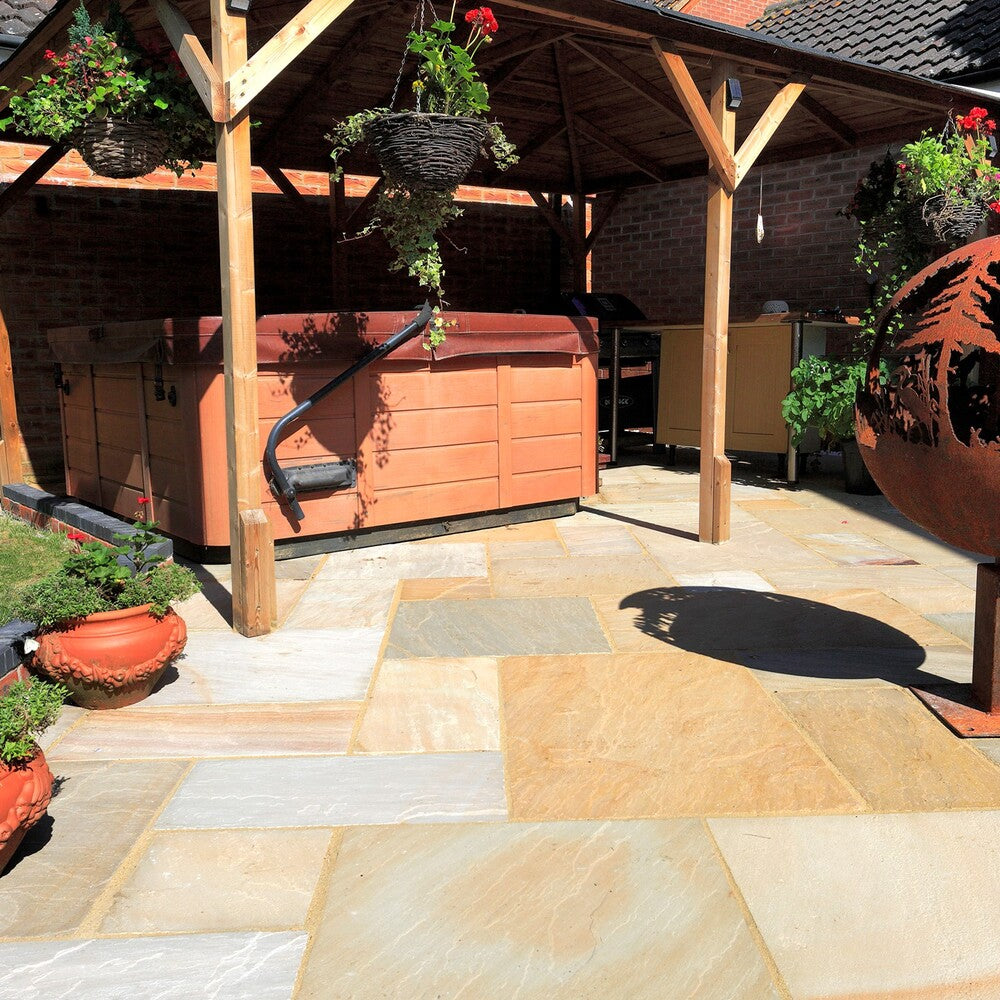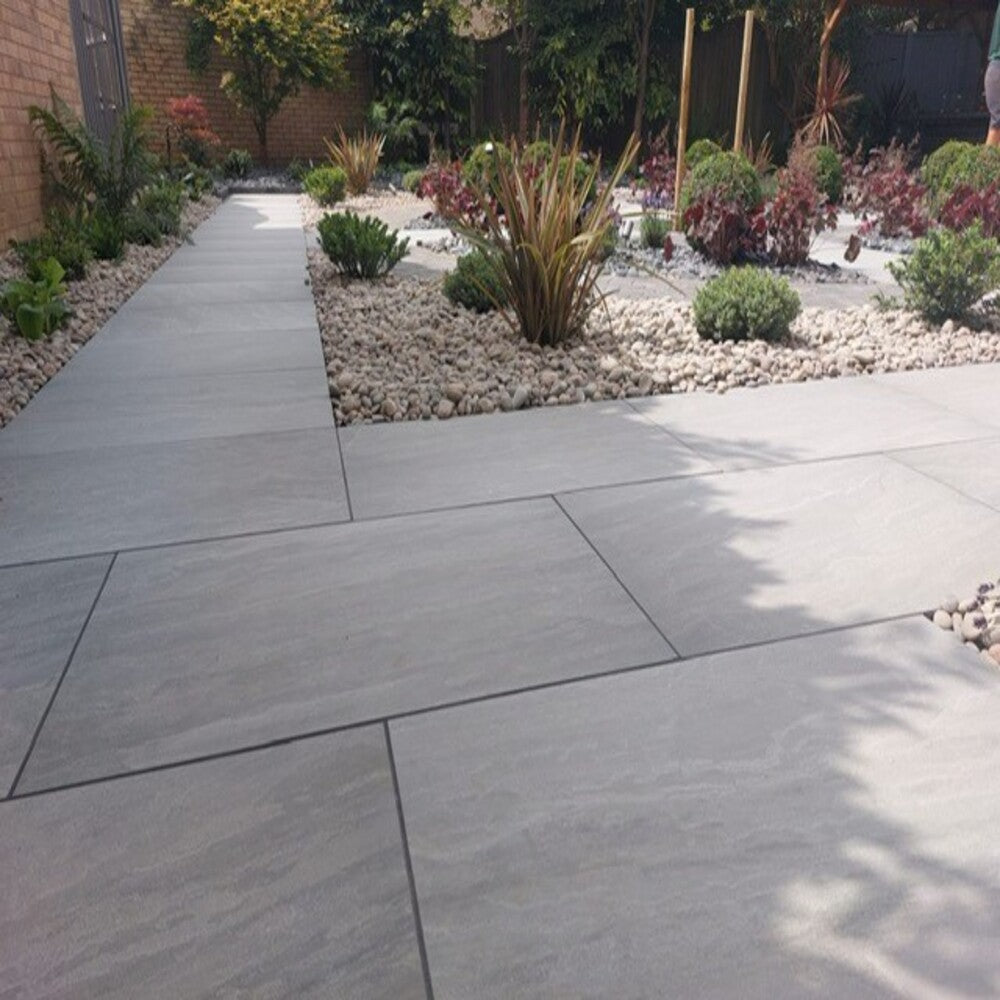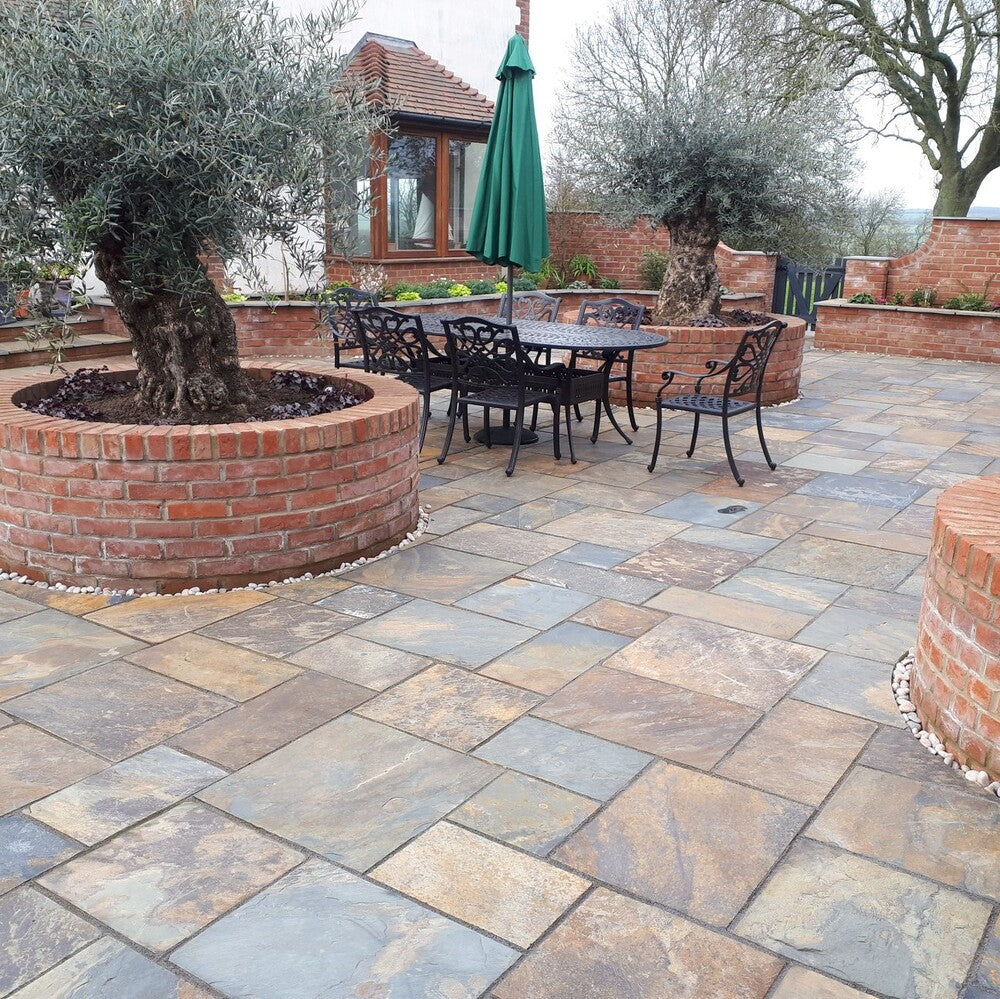Introduction - Time to spend more time in your garden!
As the weather starts to warm and the outdoors becomes more inviting, now more than ever it’s important to have a garden that you want to spend time in. At present, we can’t venture to parks, public gardens or large nature reserves, so having a garden to spend time in should be a priority.
Creating a welcoming garden that you are happy to spend time in can be a costly and time consuming process. But it doesn’t have to be. There are only a few basic elements that are required to create a garden space that is warm, welcoming and comfortable and they are not all that expensive to create if you carefully consider each step.

View Our Cream Porcelain Paving Ranges Here
For a welcoming garden you need the following at minimum:
- A seating area
- An element of shade
The rest can come later. If you want to spend time in your garden, then the above is all you need as a start.
Then, once you have the basics on place, the following elements are suggestions of things to get working on to make the space more comfortable:
- Colour
- Plants & crops
- A heating element
Once these elements are in place, you will have a comfortable, functional and fulfilling garden to spend your long days and evenings in. Let’s go through each element in turn so you know exactly what each element requires:
Creating your seating area
The seating area requires two basic elements to be functional:
- A solid foundation
- Comfortable furniture
Your seating area won’t be pleasant if it’s rocking on an unstable foundation; it won’t be nice if you don’t have furniture you like sitting on. Spending time outside is wonderful for your health and well-being, so you want this seating area to be inviting and comfortable to make spending time outside a pleasure.
The foundation - This is the basic element of your seating area. The quality of your seating area relies on this being done correctly. If you lay a solid foundation, you can spend years on your seating area without trouble.
There are two main options here, a patio or a deck. Both have the pros and cons which you can read about here. However, a patio is a sturdier and longer lasting choice, so we’ll focus on that here.

View Indian Cooper Slate Paving Here
If you’re on a budget, you can install a patio yourself. It wont be to a professional standard, but you will get the job done at less than half the cost. You need a certain amount of tools and handiness, but overall if you take your time and stick to the recommendations, you can get this done cost-effectively. If you have the luxury of a large budget, it is worth getting a professional in as they can complete this in a very short space of time to a high-degree of accuracy.
Comfortable Furniture - There are so many options for patio furniture and you want to make sure you get it right. There are so many considerations here, but the key one is that you get the material choice correct. There are a huge number of materials available and we are not experts in the matter, but we have found a very useful guide which illustrates the pros and cons of each available material here. So hopefully you can take a read and decide what is the best option for you.
An Element of Shade
Once you’ve got your seating area sorted, the often forgotten part of your space is to create an area of shade. You often don’t realise how important it is until the sun is beating down and you have to retreat indoors! This defeats the whole point of creating your seating area - when the weather is nice, you want to spend time in it, not have to run from it! So, shade is a crucial element, don’t forget it!
There are 3 main options for creating shade:
An outdoor parasol - A budget option that gets the job done effectively. Once the seating area is planned, you can find many large, great quality parasols which will provide as much shade as you possibly need. For around £100 you can get a large, self-standing parasol to sit under if you are on a budget.
A pergola - This is a popular option which involves a little construction. Pergolas are becoming increasingly popular as people realise they simply can’t go without shade over their patio area. This is a tricky thing to install unless you’ve done it before and involved concreting the base into place and then constructing the rest of the frame. It can be tackled alone, but there are also companies who will install this for you. This option should be considered if your seating area is out into your space rather than adjacent to your house. You’ll need a free-standing structure to provide shade in this situation.

A Canopy - Finally, a canopy is a good option if your seating area is up against your house. It can be done in many different ways, but commonly attaches to your house and extends out from there over your seating area. A company will have to come out and install this for you, so it can sometimes come at an extra cost, but it is really a great idea as it makes your space really feel like an extra part of the house.
Adding a splash of colour
Once the very basics are in place and you can begin to spend time in your space, you can start to make it feel more cosy and add your own touches. The first is to add an element of colour that helps add your personality, or an element of style to the space. You want to avoid just splashing random patches of colour and approach it in one of two ways:
- Use two colours, one dominating colour palette such as greys, creams or browns & one accenting colour to draw the eye such as a pastel, or a directly contrasting colour. This is a more modern effect - add the accenting colour wherever you want visiting eyes to go.
- Use one palette for everything. Pick a colour palette you like and make sure everything sticks within this rule. For example, shades of grey, earth tones, warm colours - whatever it is you go for, you need to stick hard and fast to it and have as little accenting or contrasting colours as possible. This keeps the garden feeling traditional and doesn’t draw the eye in any particular direction allowing the garden to be viewed as one cohesive space.

View Our Colourful Indian Sandstone Ranges Here
Plants & Crops - Add life to your space
Adding literal life to your space is an amazing way to elevate your space above and beyond what you can achieve with just hard landscaping. There is something pleasing to soul knowing that your garden fosters life and is constantly growing, creating oxygen and changing throughout the year. It’s a wonderful feeling when done properly and you can find a wonderful, extensive guide from Real Homes here: https://www.realhomes.com/advice/how-to-choose-plants-for-your-garden - this guide gives you full advice on the kind of plants to choose depending on your garden, as well as a few pieces of advice to ensure it survives year round. It’s really worth a read.
However, there are a few things we’d like to touch on to make sure the planting is in tune with the rest of the space. It’s important to get the right plants in place, but they need to fit stylistically with the rest of the space, so here are some pointers on how to make sure you achieve that goal.
Contemporary Space - If you are trying to create a contemporary (modern) space then you need to make sure your plants are in keeping with this. Contemporary spaces work around drawing the eye to specific places in the garden by creating standout features and accenting colours. So there are two things you can do with plants here: first, you can use isolated, large, standout plants to create feature spots. The key is to isolate them so they can really stand out. The second thing you can do is keep all the colours of your plants the same, blues & purples, reds & pinks etc. Other than the greenery of the plants, you want the colours of your plants to really stand out. The greenery will do it’s bit, but make sure your colours are chosen with intent.

View All Grey Porcelain Paving Ranges Here
Traditional Space - Difficult to master but a complete joy if done correctly. Almost the opposite to a modern space, you don’t want any standout features - you want the entire garden to feel like one space. It should be explored, every time you look closer there should be something new that you haven’t seen before. Nothing should draw the eye in one particular direction and it should be a pleasure to walk through it and look closer when you have the time. Your plants should compliment this - none of them should stand out over the rest. They should work together. There should be long, continuous plant beds with a mixture of colours, plants and grasses working together, none standing out over the rest. You’ve got real freedom to create what you want based on the plants you’ve learned can survive your space. You should end up with something that feels natural, authentic and helps you experience your space.

View Autumn Brown Sandstone Paving Here
A Heating Element - Spending extra hours outside
This is the final element of your garden that really brings it to life. Everything needs a heart and the heating element acts as the heart of the space. It means you can spend those extra few hours outside when it gets a little colder, it makes spring arrive earlier and summer leave later. This is just a small addition to your space which makes so much difference. There are a few ways to go with this, all of which come with their pros and cons:
Patio/Space Heater:
A stand-up electric heater which you will often find gracing your local pub smoking area.
Pros:
- Warms quickly
- Pleasant temperature
- No effort
Cons:
- Expensive to buy
- Expensive to run
Fire-pit:
A dish or bowl that sits on your patio area and heats the seats around it.
Pros:
- Inexpensive
- Easy to refill with fuel
- Practical uses (roasting marshmallows!)
Cons:
- Not a huge heat output
- Needs emptying regularly
Chiminea:
A chimney for your patio. It sits on or behind your seating area and burns solid fuel.
Pros:
- Great heat output
- Efficient with fuel
- Inexpensive
Cons:
- Difficult to fuel and refuel
- Can produce lots of smoke
This should be a stress free decision. Go with the option you like and make sure it suits the rest of the surrounding. It will make a great deal of difference to your area, so just make sure you add some element of heat.
In conclusion - Time to get started
There are only limited elements that you need to produce in order to have a pleasant garden to spend time in. If you approach it in a methodical manner and realise that you don’t have to do everything in one go, then you can add to it bit-by-bit until you have the garden of your dreams. Approach it as a 6 step process, and do it bit by bit:
- Build a seating area - foundations & furniture.
- Add shade
- Add colour
- Add life - plants & crops
- Add heat
- Add extra decorations
And that’s it. You’ve got a fulfilling space that you’ll love spending time in. It’s not too hard to get started, it’s just knowing where to start. By following just these 6 steps, the end result is something you can be proud of.




